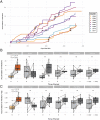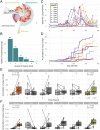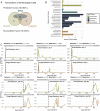The virota and its transkingdom interactions in the healthy infant gut
- PMID: 35320047
- PMCID: PMC9060457
- DOI: 10.1073/pnas.2114619119
The virota and its transkingdom interactions in the healthy infant gut
Abstract
SignificanceMicrobes colonizing the infant gut during the first year(s) of life play an important role in immune system development. We show that after birth the (nearly) sterile gut is rapidly colonized by bacteria and their viruses (phages), which often show a strong cooccurrence. Most viruses infecting the infant do not cause clinical signs and their numbers strongly increase after day-care entrance. The infant diet is clearly reflected by identification of plant-infecting viruses, whereas fungi and parasites are not part of a stable gut microbiota. These temporal high-resolution baseline data about the gut colonization process will be valuable for further investigations of pathogenic viruses, dynamics between phages and their bacterial host, as well as studies investigating infants with a disturbed microbiota.
Keywords: infant; microbiota; transkingdom; virome; virota.
Conflict of interest statement
The authors declare no competing interest.
Figures




Similar articles
-
Transmission and dynamics of mother-infant gut viruses during pregnancy and early life.Nat Commun. 2024 Mar 2;15(1):1945. doi: 10.1038/s41467-024-45257-4. Nat Commun. 2024. PMID: 38431663 Free PMC article.
-
The role of virome in the gastrointestinal tract and beyond.FEMS Microbiol Rev. 2022 Nov 2;46(6):fuac027. doi: 10.1093/femsre/fuac027. FEMS Microbiol Rev. 2022. PMID: 35700129 Free PMC article. Review.
-
Beyond the Bacterial Microbiome: Virome of Human Milk and Effects on the Developing Infant.Nestle Nutr Inst Workshop Ser. 2020;94:86-93. doi: 10.1159/000504997. Epub 2020 Mar 20. Nestle Nutr Inst Workshop Ser. 2020. PMID: 32200373 Review.
-
Early life dynamics of the human gut virome and bacterial microbiome in infants.Nat Med. 2015 Oct;21(10):1228-34. doi: 10.1038/nm.3950. Epub 2015 Sep 14. Nat Med. 2015. PMID: 26366711 Free PMC article.
-
The human gut microbiota and virome: Potential therapeutic implications.Dig Liver Dis. 2015 Dec;47(12):1007-12. doi: 10.1016/j.dld.2015.07.008. Epub 2015 Jul 18. Dig Liver Dis. 2015. PMID: 26257129 Free PMC article. Review.
Cited by
-
The case for microbial intervention at weaning.Gut Microbes. 2024 Jan-Dec;16(1):2414798. doi: 10.1080/19490976.2024.2414798. Epub 2024 Oct 28. Gut Microbes. 2024. PMID: 39468827 Free PMC article. Review.
-
Gut microbiome in the first 1000 days and risk for childhood food allergy.Ann Allergy Asthma Immunol. 2024 Sep;133(3):252-261. doi: 10.1016/j.anai.2024.03.010. Epub 2024 Mar 16. Ann Allergy Asthma Immunol. 2024. PMID: 38494114 Review.
-
Mobile genetic elements: the hidden puppet masters underlying infant gut microbiome assembly?Microbiome Res Rep. 2024 Nov 9;4(1):7. doi: 10.20517/mrr.2024.51. eCollection 2025. Microbiome Res Rep. 2024. PMID: 40207272 Free PMC article.
-
Improving gut virome comparisons using predicted phage host information.mSystems. 2025 May 20;10(5):e0136424. doi: 10.1128/msystems.01364-24. Epub 2025 Apr 8. mSystems. 2025. PMID: 40197051 Free PMC article.
-
Infant gut DNA bacteriophage strain persistence during the first 3 years of life.Cell Host Microbe. 2024 Jan 10;32(1):35-47.e6. doi: 10.1016/j.chom.2023.11.015. Epub 2023 Dec 13. Cell Host Microbe. 2024. PMID: 38096814 Free PMC article.
References
-
- Wang B., Yao M., Lv L., Ling Z., Li L., The human microbiota in health and disease. Engineering 3, 71–82 (2017).
-
- Poyet M., et al. , A library of human gut bacterial isolates paired with longitudinal multiomics data enables mechanistic microbiome research. Nat. Med. 25, 1442–1452 (2019). - PubMed
MeSH terms
LinkOut - more resources
Full Text Sources

